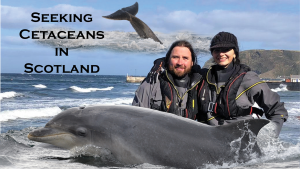Cetaceans – Whales, Dolphins and Porpoises
A blog post by Felicity
My first ever blog post was about the Grey Whales of Magdalena Bay in Mexico. I really tried to keep my blog posts shorter in those early days, but quickly gave up on that. In that first post I talked about my admiration for marine life, cetaceans especially, and I briefly touched on where some of my fascinations with them comes from when I mentioned Spindle Neurons.
These blogs began purely as travel blogs, so I swiftly moved on to describe our wonderful experience in Magdalena Bay. Now that we have been to Scotland to work with the CRRU (Cetacean Research and Rescue Unit) for Seeking Cetaceans in Scotland, for this post I would like to delve a bit deeper into, what I believe are incredible creatures.
The Evolution Of Cetaceans
There are three main groups which Cetaceans are divided into. Archaeocetes, meaning ‘ancient whales’ which are now extinct, Mysticetes meaning ‘baleen whales’ and Odontocetes meaning ‘toothed whales’. For this section we are going back to the beginning, we are going back to the group collectively known as the Archaeocetes. (50-23 million years ago)
There is a taxonomy group called Whippomorpha or sometimes Cetancodonta and it contains all living Cetaceans and Hippopotamuses as well as all their extinct relatives.
That’s right, believe it or not, cetaceans share a common ancestor with the Hippopotamus!
They evolved about 50 million years ago from even-toed undulates (Hoofed animals that spread their weight evenly over two of their five toes such as Deer, cows and Giraffes.)
If you can imagine a creature the size of a wolf with long slender legs and a long narrow tail, that is what the oldest species we really recognise as an early cetacean looked like. They are called pakicetids and lived in parts of India and Pakistan. Their remains suggest they were waders rather than full swimmers.
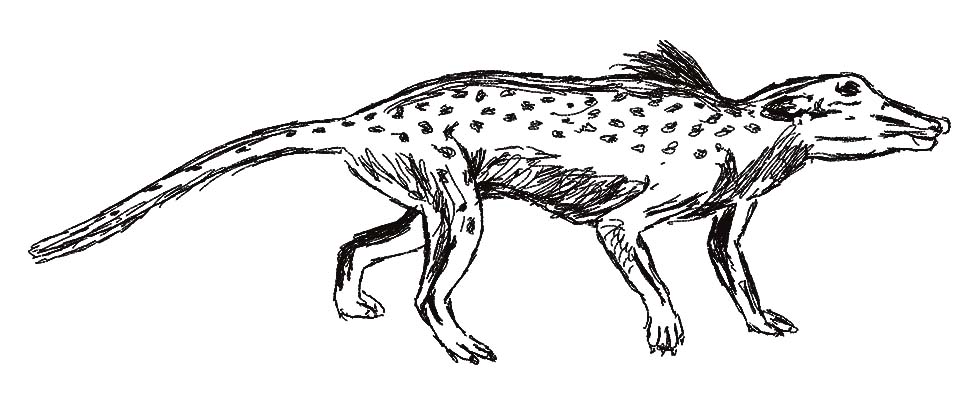
While it is true that visually they don’t resemble modern cetaceans, internally they actually shared some important features with them. The structure of their ear bone and the shape of their ear region is unusual plus the shape of their skull is similar to modern cetaceans although missing the blowhole at this early stage. From their appearance, you may expect their teeth to be somewhat dog-like but with their serrated triangular teeth, they more closely resemble modern whale teeth.
From this early point on the evolutionary ladder, there are several steps, spanning about fifty million years, before you reach cetaceans as we know them today. For the first four or so steps they were not fully adapted to an aquatic environment but in a transitional stage where they spent more and more time in water (some were even believed to have been amphibious at one stage due to the fossil evidence of a foetus positioned for a head-first delivery, as opposed to the tail first position marine species require to prevent drowning during birth) but were still able to go on land. At each step along the way their bodies adapted to the marine environment they would one day inhabit.
Their eyes were once small and placed atop their heads more like a crocodile than a cetacean but by about 40 million years ago they had become the large, laterally orientated eyes resembling those of modern cetaceans.
It was about 35 million years ago that these early relatives became fully aquatic and visually resembled what we picture when we think of cetaceans. They were fully marine and the fossilised stomach contents suggest they ate fish. At this stage, they were called Basilosaurids and while they looked the part, internally they still had a way to go.

At this point, they lacked the melon organ (a fat pad/tissue located in the forehead of modern toothed cetaceans which acts as a sound lens) and thus could not yet echolocate. The nasal passage had moved from the tip to higher up the snout but was not yet in the position of modern cetaceans blowholes. Their ears were also in a transitional stage being functionally modern but still retaining large ear holes, unlike modern cetaceans. The Basilosaurids were about 18 feet long so as large as some of today’s larger cetaceans but one of the most notable differences in my opinion was their brains. Modern cetaceans have very large brains while the Basilosaurids had small brains. This suggests they were solitary and did not have the complex social structures witnessed in many modern cetacean species (they were small-brained and big-toothed which is the reverse to modern cetaceans!)
Along the way, as species diversified, there were many incredible adaptations but as seems to regularly be the case with evolution, we lost many of those species along the way. One such species was called the Squalodon. Existing 20 million years ago, it resembled a modern-day river dolphin but the name actually means ‘shark tooth’. I like the link to dinosaurs with this species (it was originally mistaken for an Iguanodontid dinosaur fossil) but what I like even more is the mental image of all the people that want to kiss and cuddle a dolphin being confronted with this angelic-looking creature with a sharks smile!
Modern cetaceans comprise of two main groups which we mentioned earlier – Odontocetes aka the toothed whales and the Mysticetes aka the Baleen whales. It was about 35-36 million years ago that echolocation and filter-feeding evolved.
Modern Cetaceans
Mysticetes (Baleen Whales) are filter-feeding whales. If you picture the largest whale species such as the Rorquals- The Blue, the Fin and the Humpback whales or the Right whales, Grey whales or the smaller Minke whales- they all have Baleen plates. Along the top jaw of these whales, they have what looks like bristles or hair hanging down in curtains. This Baleen is made out of Keratin, the same as human hair and fingernails. The Baleen plates can differ in size, colour, stiffness etc from one species to the next and slightly in how the whales use them depending on feeding technique but generally, the whales open their mouths to take in water. They then filter the water out through those baleen plates which catch small creatures such as krill which then become dinner for the whales.
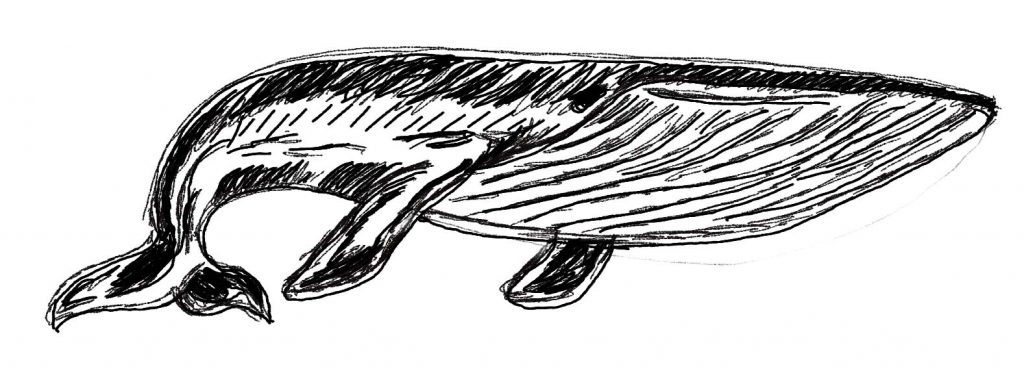
Odontocetes (toothed whales) obviously include all of the cetaceans with teeth instead of Baleen plates. Picture the mighty Sperm Whale, the beaked whales, dolphins and porpoises. They range in size from about 55 feet to 4.5 feet. What makes them special though is the ability to echolocate. Thanks to the Melon organ (mentioned that earlier too) they can use sonar to hunt their prey and do not need to rely on vision. This also allows them to dive deeper in search of food as they do not require light to hunt. The melon acts as a directional, amplifying sound lens so when the cetaceans emit a series of clicks at various frequencies, they can be focused via the melon and as the sound is reflected off objects, the cetaceans receive that information through their lower jaw and through the auditory nerve the information ends up in the brain.
An interesting fact here too – humans and most other mammals have one primary auditory centre in the brain but cetaceans have two suggesting something very complex in sound processing is happening here but we don’t yet understand exactly what!
Through this sense, they can not only see the shape of the object but they can also see inside it. This opened up a whole new world to them and a wider range of hunting techniques and prey options became available to them. It is this ability that makes them ‘more evolved’ than the Baleen whales.
Toothed Cetaceans have some wonderful adaptations. Any diver knows the troubles we can have with squeezes, reverse squeezes or, worse still, the bends. Cetaceans live in the sea but they are still mammals. They can actually suffer these same conditions but have found their own special ways to cope with them. When a human dives, they have to equalize their air spaces to prevent a squeeze, usually by holding the nose and gently blowing against it. Some species of cetacean have a special vein that lines the middle ear cavity which becomes engorged at depth, thus reducing or obliterating the air space preventing the development of the squeeze. There are a few places in their body where this happens to reduce the squeeze and they lack the frontal cranial sinuses that are present in terrestrial mammals.
Another organ susceptible to compression damage is the lung which is why divers are taught above all else that you never, ever hold your breath when diving. Even if you have run out of air and must make an emergency ascent, you blow out a steady, continuous stream of bubbles or else risk serious damage to your lungs. In deep diving cetaceans (and seals), the peripheral airways are reinforced which allows the lungs to collapse during a deep dive. By collapsing the lungs in this way, the gas exchange between blood and lungs is prevented thus the absorption of nitrogen into the blood does not happen. No nitrogen narcosis, no nitrogen bubbles aka the bends.
To cope with this lack of oxygen in the lungs, deep-diving whales (and seals) have a large amount of oxygen stored in their blood and muscles. Cetaceans actually have more blood and a higher concentration of haemoglobin when compared to terrestrial mammals for their body mass as well as a higher concentration of myoglobin, an oxygen storage protein found in their muscles.
Put simply, deep-diving cetaceans, such as the sperm whales and bottlenose whales who have been recorded to dive as deep as 6,000 feet on a dive that can last for up to an hour, have air cavities with venous plexuses (veins) which fill to obliterate any air spaces thus preventing the squeeze. They have collapsing lungs to prevent nitrogen issues such as the bends. They also have special stores of oxygen in their blood and muscles.
As well as these incredible adaptations in the deeper diving cetaceans, some cetaceans have been noted to perform their own decompression dives. This is where, after a long dive, they perform many shorter dives, reducing in depth each time to reduce any adverse effects caused by a deep dive. This added to the fact that a dolphin can replace as much as 95 per cent of the air in their lungs in a single breath (humans replace about 65 per cent per breath) and I think everyone can agree they have some amazing adaptations and have come a long way in those 50 million or so years.
At last count (and it does change relatively regularly as new species are discovered and sadly some endangered ones go extinct) I believe there are over 90 species of cetacean on record inhabiting the worlds oceans, lakes and rivers. Some species, like Orca (Killer Whales) and Bottlenose dolphins have adapted so well that versions of them can be found all over the world. They may not all look the same or act the same but that is down to their versatility and adaptability – they have learned varied and specialised hunting techniques and developed adaptations to let their species flourish.
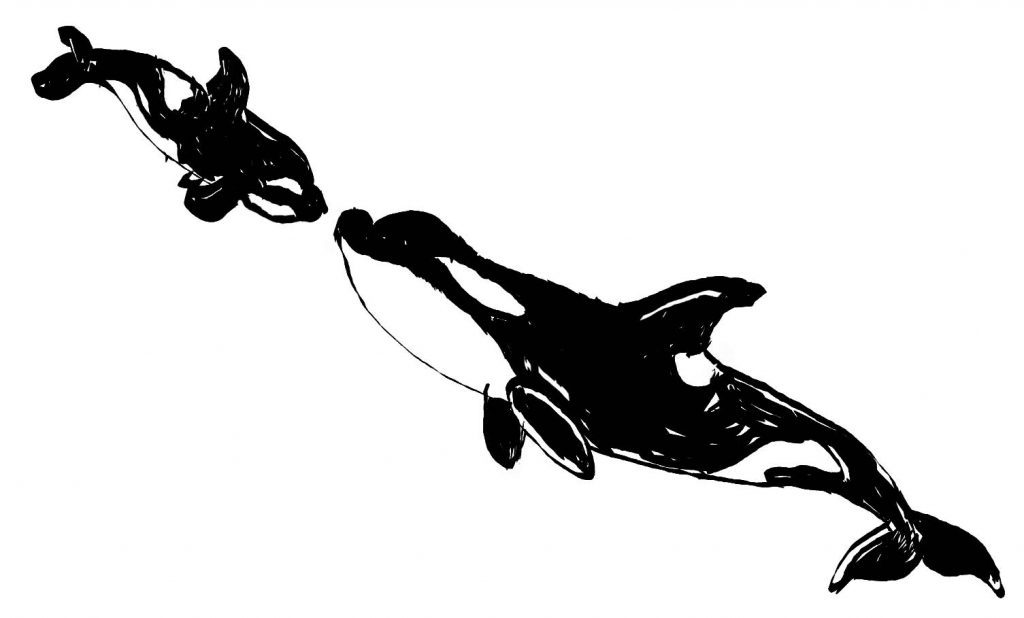
Other species are not so adaptable and can only be found in limited locations and many are nearing extinction now. Sadly a huge amount of that was down to the whaling industry where humankind obliterated whale numbers to the point that many species are still unable to repopulate and are even now nearing extinction. Though the tourism industry is overtaking the whaling industry, humankind is still responsible for many threats facing cetaceans today – these include overfishing, bycatch, lost fishing equipment which creates entanglement, noise pollution, plastic pollution, chemical waste pollution, oil spillage, whaling and the capture of cetaceans for amusement parks… in so many different ways we are contributing to their depletion in numbers and quality of life but I am not actually intending to go into that in detail here…
We have more information about toothed cetaceans, largely down to the fact you get smaller species of them which have, over the years, tragically been captured and kept in captivity at marine parks, dolphinariums etc. The larger cetaceans are harder to study but as technology advances, we are finding more, less intrusive, ways to study and understand these magnificent creatures.
One of the things that really intrigues me about cetaceans is their brains. I find the majority of animals amazing in their own way. Their adaptations and abilities, their habits and qualities. Life, nature, it is harsh and seemingly cruel so much of the time but in the way it all connects, it’s amazing and beautiful. Ecology is a fascinating subject and like with most things, there is always so much more to learn. For a few species though, I am particularly intrigued by their brains.
Brains.
Spindle Neurons I have mentioned in a previous blog post but did not really explain them. I am not a biologist, zoologist, neuroscientist or anything else approaching them which may be helpful at this point but I will do my best to explain it as I understand it…
Spindle Neurons are specialised projection neurons located in parts of the brain. I think of them as like highways or express trains for connecting important information to different parts of the brain quickly. They are usually found in the parts of the brain linked to communication, speech, facial expression, quick-fire responses, memory, emotion, trust, guilt, embarrassment, love, a sense of humour, empathy, intuition about the feelings of others, social organisation, social awareness, self-awareness, rapid ‘gut’ reactions and interoception. These cells are credited with allowing us to feel love and suffer emotionally.
An interesting side note about these Neurons (sometimes called VENs) is that they are decreased in number in sufferers of frontotemporal dementia, schizophrenia and agenesis of the corpus callosum. Patients suffering from such conditions suffer a breakdown in their character, lose social graces and empathy, become insensitive, erratic and irresponsible. People lack social awareness. When a disease targets these cells you get a breakdown of social functioning. A lot of people would say we lose that which makes us ourselves, that which makes us human.
At one time Spindle Neurons were thought to only exist in humans and great apes, they were touted as the brain cells that set humans and the other great apes apart from all other mammals. Now those brain cells have been found in a few large-brained species such as Elephants and Cetaceans. Interestingly considering their shared ancestry, these cells have also been found in hippopotamuses, zebra, pigs and a few other species too. In addition, less evolved versions of these cells have been found in creatures like racoons.
While VENs are most prominent in cetaceans, humans, great apes and elephants, we do not share a common ancestry but rather a case of Parallel Evolution where VENs are concerned. It may also parallel the emergence of a very large brain size in these mammals. If the presence of these Spindle Neurons is related to the emergence of larger brain size or more related to the behavioural specializations that humans, whales and Elephants have in common, I don’t know. The two seem linked to me- a larger brain being capable of higher function and emotional capacity and therefore in need of rapid transmission of this crucial social information. Without that express train, a larger brain could mean a slower brain as all that input would have further to travel.
For Cetacean species, VENs have been found in both baleen whales and toothed whale species. They have been observed in the bowhead whale, humpback whale and fin whale. They are also found in the Sperm whale, Orca/ Killer whale, beluga whale, Risso’s dolphin, and the bottlenose dolphin.
What is more, whales appear to have had these cells for about 30 million years which is at least twice as long as humans and in addition, early estimates suggest they have three times as many spindle neurons as humans do and that is accounting for the fact whale brains are larger than ours.
It is all too easy to transfer thoughts and feelings onto animals. The way my dog responds to me, the way my cat is all over me every chance she gets. They love us but what is love to them? We put our version of human emotion onto other beings where, largely, it doesn’t belong there. That isn’t to say your pet doesn’t love you, but it may not be the way we as humans classify those words, those emotions. Humans are good at anthropomorphising everything around them. I am just as guilty as anyone else but I am aware of it and try to tone it down.
Whale brains have such potential for high-level brain function which is regularly demonstrated at the behavioural level and the presence of these cells offer further proof. The way they communicate through complex songs, the way they recognise their own songs and make up new ones. They recognise each other and form coalitions to plan hunting strategies which they then teach their young. Their evolved social networks are similar to those of apes and humans and, to my knowledge, Elephants too.
As with humans, VENs were found in whales in the parts of the brain (anterior cingulate cortex and frontoinsular cortex) linked to everything I mentioned above but in addition, unlike in human brains, they have been found in the frontopolar cortex at the back of the brain, and they are sparsely dispersed elsewhere too. Scientists, to my knowledge, do not yet know exactly what this means for cetaceans and their brain capacities. It is certainly believed that it enables us to process and act on emotional cues during complex social interactions and this is very evident in many cetacean species.
While Sperm whales have the largest brains in the animal kingdom, we know more about Orca (Killer Whale) brains and what we have discovered is incredible. While it is true that the most intelligent species, such as cetaceans, elephants and primates have the largest brains, it is more than just the size of the brain which contributes to the intelligence of a species. There are four characteristics in the structure of an Orca’s brain which differ from us but make them something incredibly special. If you were to measure the cerebral cortex (associated with memory, language, thought, attention and consciousness) and how thick it is, cetaceans rank highly (but not quite as high as humans and primates) but cetaceans cortices are actually structured differently.
The next thing to look at is the gyrification (how many wrinkles and folds the cortex has. Brains with more wrinkles and folds have more nerve tissue and are faster and more skilful with handling the data. A brain with more gyrification has faster brain cell communication.) Cetaceans have significantly higher gyrification compared to any land mammal. Neuroscientists are actually bewildered at how heavily folded cetacean brains are. To give you an idea, a human brain measures 2.2 for gyrification while the bottlenose dolphin is 5.62. Orca has the record for the most gyrified brain in the world at 5.70.

Orca also have a highly developed paralimbic system. This part of the brain is related to spatial memory and navigation. More meaningful to me though is their highly developed amygdala which is linked with emotional learning and long-term memory.
The one that really gets me though is the insular cortex in Orcas which are the most elaborated in the world. The insula cortex is linked to consciousness, emotions such as empathy, compassion, perception, motor control, self-awareness and interpersonal experience. Again, it is those emotional capabilities that humanity thought made them a step above other creatures and yet the Orca has a brain capable of them in a greater capacity. What’s more, Orcas are the most acoustically sophisticated animal on the planet. Everyone knows that some whales, like male humpbacks, sing, toothed cetaceans echolocate, some cetaceans use sound to shock their prey or to create a wall of sound to trap their prey but many also produce whistles, clicks and pulse calls to communicate with one another but Orca are on another level. Our communication compared to theirs is somewhat primitive. Their brains suggest that in a few areas, compared to them, humanity is primitive.
When I consider some of these cetaceans, elephants, humans and great apes, these species with large brains and these Spindle Neurons, some things they have in common jump out at me – they have a prolonged juvenile stage during which they learn from their elders. They recognise each other and develop lifelong relationships. They work together, hunt together, help one another and protect each other. Cetaceans and Elephants society is also matriarchal. They each have a clear language and they mourn their dead. They are all capable of complex, coordinated social behaviour.
I now think back to stories I have heard and videos I have seen in the past – the dolphin with a deformed spine unwanted by its own kind but who was adopted by a pod of Sperm Whales.
The humpback whale who lifted a swimmer from the water to protect them from a tiger shark. The group of dolphins who surrounded a man swimming with his child and protected them from a shark. The way humpback whales will protect other whales and even seals from Orca. The signs of empathy and altruism these creatures display. The Orca mother on Blue Planet whose baby was poisoned (thanks to humans and our pollution again) and carried the deceased calf with her until there was nothing left to carry. (There are so many stories about Elephants displaying all of these emotional capabilities too including that of their fantastic memory which they are renowned for but this post is about cetaceans)
It all amounts to one big thing to me – they are worthy and so deserving of so much more from us. They are like us in so many ways and may well be capable of a higher level of intelligence and depth of emotion if their brains are anything to go by. I do not see how humans believe it is ok to capture these sentient, highly evolved creatures and put them in tanks. To limit their lives to such a degree and to, in effect, torture them for our own amusement. It isn’t ok to do that to any animal but to the degree it has been done to cetaceans is staggering. Some countries, like Canada, have woken up to this and have banned cetaceans in captivity but so many places in other countries still hold them captive. How people can turn a blind eye to the pollution and damage we are causing to the world around us but especially to the sea, it needs to stop.
If I haven’t already lost you, I know this blog post is particularly long, talk of saving the planet is often where people glaze over. We all know humanity needs to make changes before we destroy the planet but I am often surprised by how little some of the people I talk to know about the impact we are all having on so many animals and in so many ways.
I am sure my knowledge only scrapes the surface but I want to learn. I want to make a difference. That is one of the reasons I went to Scotland to work with the CRRU. It isn’t about saving the planet overall but it is about learning, and putting what we learn to good use to help and protect the cetaceans in the Moray Firth.
This is also why we are donating £5 from each DVD of ‘Seeking Cetaceans In Scotland’ to the CRRU to help support the wonderful work they do! You can get your copy HERE.
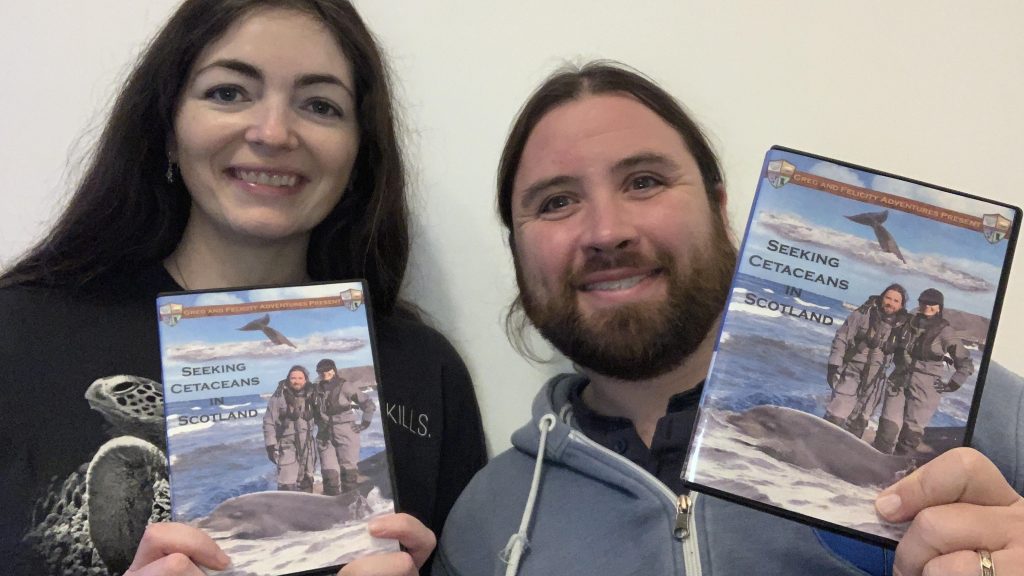
Thanks for reading,
Stay safe,
Felicity
P.S.
If you enjoyed this blog post, please leave a comment and say ‘hello’!
For information on all of our projects, visit: www.gregandfelicityadventures.com
Follow us on Instagram at: https://www.instagram.com/gregandfelicity
Like us on Facebook at: https://www.facebook.com/GregandFelicityAdventures
There are various places you can watch our documentaries and series!
Seeking Cetaceans In Scotland: A two-part documentary about the work of the Cetacean Research and Rescue Unit as they work to help whales, dolphins and porpoises in the Moray Firth in Scotland:
Free in the USA on Tubi TV at:
https://tubitv.com/movies/678018/seeking-cetaceans-in-scotland
Free Worldwide on PlexTV at:
https://watch.plex.tv/movie/seeking-cetaceans-in-scotland
With a library card on the Hoopla service where applicable:
https://www.hoopladigital.com/title/15313766
Free in the USA on Xumo at:
https://www.xumo.tv/channel/99991731/free-documentaries?v=XM00ILOFXCKLUC&p=74071
Buy it without ads Amazon’s Prime Video at:
UK: https://www.amazon.co.uk/dp/B09RVWVFCV
USA: https://www.amazon.com/dp/B09RVWJGY1
(Greg and Felicity are donating half of our streaming income on this documentary to support the CRRU).
Available to buy on DVD (with £5 from each donated to the charity): https://ko-fi.com/s/73e469d114
ROMANIA: SEEKING DRACULA’S CASTLE: Our travel documentary looking into the history, legend and castles connected to Vlad Dracula III, sometimes known as Vlad the Impaler, and a journey around Romania:
Free Worldwide on Plex: https://watch.plex.tv/movie/romania-seeking-draculas-castle
Free (USA) on Tubi: https://tubitv.com/movies/579192/romania-seeking-dracula-s-castle
Prime Video (From £1.99, no Ads) (UK): https://www.amazon.co.uk//dp/B08RDPZP14
Prime Video (From $1.99, no Ads) (USA): https://www.amazon.com/dp/B08RDJR4F2
TURKEY: FAIRY CHIMNEYS AND UNDERGROUND CITIES: A travel documentary across Turkey, from the Fairy Chimneys and Underground Cities of Cappadocia to the ancient Greek ruins of Ephesus and Hierapolis:
Prime Video UK (From £2.49, no Ads): https://www.amazon.co.uk/Turkey-Fairy-Chimneys-Underground-Cities/dp/B09KKSZLRW
Prime Video USA (From $1.99, no Ads): https://www.amazon.com/Turkey-Fairy-Chimneys-Underground-Cities/dp/B09KK6VDJB
Free Worldwide on Plex: https://watch.plex.tv/movie/turkey-fairy-chimneys-and-underground-cities
Free (USA) on Tubi: https://tubitv.com/movies/579225/turkey-fairy-chimneys-and-underground-cities
Greg Chapman’s Magic Show: An eight-part series of magic and entertainment with Greg:
Free in the USA on Tubi at: https://tubitv.com/series/300008713/greg-chapman-s-magic-show
Free worldwide on Plex: https://watch.plex.tv/show/greg-chapmans-magic-show/season/1
Available to buy on DVD: https://ko-fi.com/s/7c1bc10a08
Mexico: Mayan Mystery and Marine Majesty: Filmed on our honeymoon in Mexico in 2019, our first travel documentary took us through the ancient sites of Teotihuacan, Uxmal, El Tajin, Palenque, Chichen Itza and Calakmul, and then on to see the whales of Magdalena Bay, whale sharks of La Paz, and more.
Watch free on YouTube: https://youtu.be/yfMpD868MHU
The Isle of Man: Railways, Castles and Seals: Our second travel documentary took us to the Isle of Man!
Watch free on YouTube: https://youtu.be/uCpUa6XEkbg
